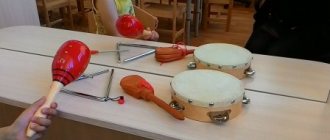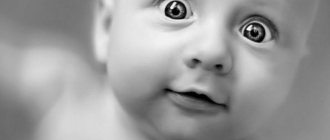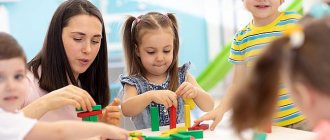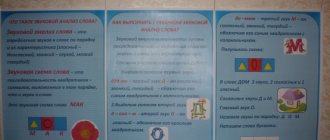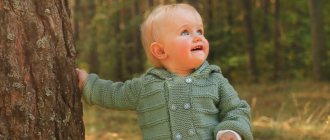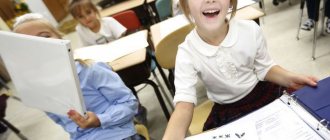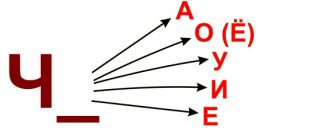Features of the dynamic side of speech
1. Pace (normal, fast, slow)___________________________________________
2. Rhythm______________________________________________________________________________
3. Correct use of pauses ___________________________________________________
4. Use of the main types of intonation (narrative, interrogative, incentive)_________________________________________________________________
Reproduction of the sound-syllable structure of a word
| older | older | will prepare | will prepare |
| house, snow, roof, bridge, porridge, bread, cat, cabbage, tomatoes, draft, frying pan, temperature, whistle, birdhouse, aquarium, medicine, curdled milk, snowdrop | |||
| The boys made a snowman. A plumber fixes a water pipe. Hair being cut in a barbershop. A policeman rides a motorcycle. A traffic controller stands at an intersection. |
Phonemic awareness state
1. Repetition of syllables with oppositional sounds:
From 5 years
pa-ba ____________ ba-na _____________ wa-ta ___________
ta-da _____________ me-ma _____________ na-ga ___________
ta-na _____________ ga-da _____________ ka-ga ____________
From 6 years old
ba-ba-pa ____________ ta-da-ta ____________ ha-ka-ga ___________
ba-bya-ba ____________ sa-sha-sa ____________ zha-za-zha _________
cha-sha-cha ____________ for-sa-for _____________
Differentiation of oppositional sounds that are not mixed in pronunciation
Show pictures
:
Bear-mouse _________________ duck-fishing rod ________________
barrel-bud ____________________ grass-firewood __________________
3. Differentiation by hearing of sounds mixed in pronunciation:
bowl - bear __________________ rat - roof _________________
river - radish __________________ bangs - crack ________________
flower-Svetik ____________________ wind-evening __________________
goat braids _______________________
State of phonemic analysis and synthesis
from 5 years:
1. Isolating a given sound [m] or [r] from words. According to the task, find out whether the sound [m] (mooing of a calf) or the sound [r] (motor) is heard in the words: mouse, mosquito, board, window, frame, house, fish, firewood, table, ball _____________________________________________________________________
2. Emphasizing the stressed vowel at the beginning of a word (“Tell me, what is the first sound in the word?”):
Anya, stork, wasps, duck, Olya, Ira, Inna, street ____________________________________________
from 6 years old:
1. Definition of the first consonant sound in words (“Tell me, what is the 1st sound in a word”?): poppy, smoke, grass, cat, sparrow, bun, cup, pike __________________________________________
2. Definition of the last sound in words: house, poppy, reed, key, tank, fly, drum, pipe
__________________________________________________________________________________.
3. Determining the sequence of sounds in a word (“What sounds are in words?”): poppy, soup, onion, porridge, frame ___________________________________________________________________________
4. Determining the number of sounds in words: house, cancer, moon, owls, banana, lamp
__________________________________________________________________________________
Speech Comprehension Study (Impressive Speech)
Passive dictionary
· Vocabulary volume ________________________________________________________________
· Accurate understanding of word meanings_____________________________________________
Show me where the doll, table, chair are.
Plant a doll, a bear, etc.
Understanding different grammatical inflections.
· Differentiation between singular and plural nouns
Show me where:
table - tables ____________ house - houses _____________ chair - chairs _________
tree—trees __________ birch—birches _________ cup—cups _________
pencil - pencils _____________
· Distinguishing prepositional-case constructions with prepositions (in, on, by, under, over, before, behind, about).
Show where the spoon is: in the glass, on the glass, under the glass, etc.
__________________________________________________________________________________
· Differentiation of prepositional-case constructions with prepositions in - from, on - with, under - from under:
Take a ruler from the pencil case, from the pencil case, from under the pencil case _____________________________________________
Put the pencil in the pencil case, on the pencil case, under the pencil case _________________________________________
3 Differentiation of word formation forms.
· Differentiation of diminutive nouns (show where)
house - house _____________ chair - high chair ___________
blanket - blanket __________ pillow - pillow ___________
lock - lock _____________ mushroom - fungus ___________________
doll - doll ______________ cup - cup _________________
* Differentiation of verbs with different prefixes:
walked _______ left _______ entered _________ left __________
moved ______ came in _________ left ___________
Understanding phrases and simple sentences (show)
Collocations
key pencil _________________ key pencil _______________
where is the owner of the dog __________________ where is the owner's dog _______________
mother's daughter _________________________________ daughter's mother _____________________
Offers
The girl picks flowers. ______________________________________________________________
Girl playing with a ball ____________________________________________________________
The girl is cleaning the room. ___________________________________________________________
5. Understanding interrogative sentences:
Who is the girl catching? _______________________________________________________________
How does a girl catch a butterfly? ______________________________________________________________
Who catches the butterfly? _________________________________________________________________
From 6 years old
Understanding complex and complex logical and grammatical structures
Petya catches up with Misha. Who runs first? _____________________________________________
A boy runs from a dog. Who's running behind? ___________________________________________
Olya lost the pencil she took from Vova. Whose pencil was this? ____________________
Dad was reading the newspaper after he had lunch. When did dad read the newspaper: before lunch or after lunch? _________________________________________________________________________________
Study of vocabulary and grammatical structure of expressive speech
· Name pictures by topic
Name a group of objects in one word
| Specific nouns | |||
| older | older | will prepare | will prepare |
| toys | |||
| dishes | |||
| cloth | |||
| shoes | |||
| vegetables | |||
| fruits | |||
| furniture | |||
| Dick. alive | |||
| house. alive | |||
| trees | |||
| flowers | |||
| transport | |||
| tools | |||
| berries | |||
| birds | |||
| heads headdresses | |||
| insects |
| Generalizing concepts | |||
| older | older | will prepare | will prepare |
| toys | |||
| dishes | |||
| cloth | |||
| shoes | |||
| vegetables | |||
| fruits | |||
| furniture | |||
| Dick. alive | |||
| house. alive | |||
| trees | |||
| flowers | |||
| transport | |||
| tools | |||
| berries | |||
| birds | |||
| heads headdresses | |||
| insects |
· Name nouns denoting parts of the body, parts of objects
From 5 years
· Body parts: head, legs, arms, nose, mouth, chest, stomach, neck, etc.______________________
· Parts of clothing: sleeve, collar, button_____________________________________________
· Parts of furniture: back, leg, seat_________________________________
· Parts of the car: door, wheels, steering wheel, cabin ___________________________________
From 6 years old
· Body parts: elbow, knee, fingers, nail_________________________________
· Parts of garments: collar, cuff, loop________________________________
· Car parts: body, cabin, headlights, engine___________________________
· Window parts: frame, window sill, glass ___________________________________________
· Names of professions ______________________________________________________________
__________________________________________________________________________________
__________________________________________________________________________________
· Verb dictionary. Use of verbs when answering questions.
From 5 years
· What do you do during the day? _________________________________________________
· How does one move? ______________________________________________________________
· Who is screaming? ______________________________________________________________
From 6 years old
Who does what (using job titles)? _________________________________
__________________________________________________________________________________
· Adjectives
Name of flowers
: white, black, red, blue, green, yellow, brown, pink, blue, orange ________________________________________________________________
Form name:
round, square, triangular, oval, rectangular ____________
__________________________________________________________________________________
· Selection of antonyms (from 6 years old):
big - long - full -
tall - wide - thick -
stupid - sweet - a lot -
close - good - easy -
Inflection state
1. Use of nouns in the nominative singular and plural:
| older | older | will prepare | will prepare |
| table | |||
| cup | |||
| pencil | |||
| house | |||
| chair | |||
| tree | |||
| window | |||
| bucket | |||
| bee | |||
| cucumber | |||
| sparrow | |||
| dress | |||
| egg | |||
| ear | |||
| a lion |
2. The use of nouns in indirect cases without a preposition:
I have a pencil (doll). I don't have a pencil. ___________________________________
I have no … ______________________________________________________________________
I'm drawing …_________________________________________________________________________
Dad writes …_______________________________________________________________________________
3.Use of the genitive plural form of nouns:
| older | older | will prepare | will prepare |
| ball | |||
| birch | |||
| table | |||
| cup | |||
| house | |||
| book | |||
| tree | |||
| ball | |||
| sheet | |||
| key | |||
| chair | |||
| pencil |
Texts for differentiating words with opposition phonemes
Galya and Kolya went with dad to the garden. There were many butterflies in the garden. Galya said: “Daddy, look how many butterflies there are here.” “Yes,” said dad, “a lot.” You see, one sat on the fence. Lock gate and sit on the bench. Let's watch the butterflies. Then we will catch some butterflies for the collection. You will put them in a beautiful folder with a butterfly on the cover.”
There was a ball in the palace . One courtier tripped and fell to the floor. He hit his leg and felt severe pain. “It hurts,” he shouted. “Come on, ” the king told him, “he who is not old should be cheerful. You will not receive from me the gift that I wrote to you about . You can leave the hall ." “Okay,” replied the courtier, “when a new day comes, only a shadow will remain of me here .”
One day Tom got lost and couldn't find his house. There was a high fence around the house, and next to it stood a large white cathedral. Tom galloped along all the roads and looked for the cathedral. Salty sweat poured from his forehead in streams. He could not find either the cathedral or the fence. was walking towards me . Bill said to Tom, “You must have had some whiskey today. After all, your home is nearby, Tom. Go home quickly, light the fireplace, dry yourself and warm up. After all, you were wet in the rain for a long time and could have caught a cold.” “Thank you, Bill,” said Tom, “this is truly my home.” Here is the cathedral, here is the fence.”
Dictionary recovery
The word is the basic semantic unit of speech. If you ask any person what human speech consists of, he will answer: words. In this regard, regaining the ability to understand and pronounce words is of utmost importance.
In patients who were “speechless” and, as a result of work on disinhibiting speech, began to pronounce individual sounds and syllables, words with a simple structure should be formed. At the same time, these words should be well known and often used. These include, for example, words such as “yes”, “no”, “give”, “want”, “can”, “will”, “okay”, “thank you”, “hello”, “bye” and etc. These words are suitable for answering many questions and, to a greater extent than others, serve the purpose of communication. By using them, the patient becomes convinced that he has ceased to be “speechless.” To reinforce these words, special questions may be presented during the day, as if provoking the patient to answer with the right word. For example: “Are you going to have lunch?” - "Will"; “Are you going to watch TV?” - "Will"; or “Do you want to have lunch?” - "Want"; “Do you want to watch TV?” - “I want”, etc.
In addition to these words, it is necessary to restore words - names of objects. This work begins by showing pictures by the names of the objects depicted on them[11]. At first the number of pictures is limited to three to five, then it gradually increases. It is useful to show pictures with any of the characteristics of the object. In this case, one of the most important is the functional sign, indicating what the main purpose of the item is. It is indicated by the question: for what? For example: what is a spoon for? (to eat, for food). In addition to functional ones, quality characteristics (shape, size, color, material), as well as such conceptual characteristics as “living-non-living”, “moving-not moving”, “thing-not-thing”, etc. are of great importance.
To practice each of the signs, the patient is asked, for example, to show where what is being written is depicted; what is used to cut; what they drink from; what they sit on, where something is depicted that is made of wood; what is made of iron; where what is round is depicted, what is long, where “living” is depicted, where “non-living” is depicted, etc.
Practicing these features allows one to approach generalizations and combine words into large groups (categories).
Usually the dictionary is systematized by topic: clothing, dishes, furniture, transport, art, etc. The meanings of words are clarified by introducing them into sentences with different meanings (i.e., in different semantic contexts). This technique is called semantic play. For example, playing on the word “glasses,” you can introduce it into the following phrases: “These are my glasses. Glasses are needed to see better. I need new glasses. Glasses are sold at the pharmacy. The doctor wrote out a prescription for glasses. Glasses preserve vision. Wear dark glasses to protect from the sun. A girl wearing beautiful dark glasses was walking along the beach. I'm happy with my glasses. The glasses fell and broke. I forgot my glasses at home and can't work. Glasses, etc. suit my friend very well.”
Each of these phrases, as it were, “highlights” the shade of meaning that is the main one in this sentence and allows you to concentrate the patient’s attention on it. In addition, the technique of semantic play demonstrates the polysemy of a word and helps to overcome subtle impairments in speech understanding, which always occur to one degree or another in aphasia. The phrases in which the word is introduced can be presented to the patient in a ready-made form for reading and comprehension, but you can also give them a different form - skip the word being practiced so that the patient finds and enters it on his own. For example, “I began to see worse, and the doctor prescribed new ones...” (glasses). Finally, you can give the patient the task of coming up with different sentences with this or that word.
The work of restoring the understanding of a word makes it easier to find the right word. The words included in the system are easier to remember, and it is easier for the patient to find them.
Below is didactic material on restoring the dictionary.
Auditory-pronunciation differentiation of sounds
⇐ PreviousPage 3 of 3
Sounds were differentiated in pairs (hard-soft, dull-voiced, whistling-hissing, r-l) in special tasks during auditory perception and repetition of syllables and words with oppositional sounds: you need to raise your hand if you hear the desired sound (called a sound in a series of isolated sounds, syllables, words); repeat syllables, words (ta-da, ta-da-ta, tom-dom, ka-ga, ka-ha-ka, da-ta, da-ta-da, bala-pala, bunny-bunny); show the named picture, name it (mouse-bear, bear-bowl, grass-firewood, reel-reel, duck-fishing rod, roof-rat, goat-braid, raspberry-Marina, Yura-yule). Assessment of auditory and pronunciation differentiation of sounds: “well formed” if all tasks were completed, “insufficiently formed” if some tasks were not completed or were completed incorrectly, “not formed” if tasks were not completed.
Phonemic awareness and sound analysis
The study was carried out according to the instructions: highlight the initial vowel sound in the word (Anya, Olya, morning); highlight the sound against the background of words (sound m in words: poppy, carrot, head, lamp, sofa, house, board, room); select pictures with the names of objects based on the sound (table, closet, boots, shoes, airplane); determine the location of the sound in a word (m in words: sailor, house, plane); pronounce words of complex sound composition and with a combination of consonants: picture, car, dynamics, snowman, TV, frying pan, aquarium, plumber, medicine, policeman, draft, curdled milk, hairdresser and sentences: The guys made a snowman. There are fish swimming in the aquarium. A policeman rides a motorcycle. A plumber fixes a water pipe. Hair being cut in a barbershop. Assessment of the state of phonemic perception and sound analysis: “well formed” if the tasks were completed correctly, “insufficiently formed” if a number of tasks were not completed or performed inaccurately, “not formed” if the tasks were performed incorrectly or the child refused to complete them.
Active Dictionary
The volume and quality of the active vocabulary, the presence of generalizing concepts, knowledge of antonym words, the ability to select epithets for words, and name an object according to its description were tested.
Grammatical structure of speech
(functions of inflection and word formation)
During the study of the function of inflection, the ability to change nouns by numbers and cases was revealed; past tense verbs - by gender, present tense - by number; the ability to coordinate nouns with adjectives in gender and number, numeral names (one, two, five) with nouns; use prepositions adequately in speech. During the study of the function of word formation, the correct formation of the diminutive form of a noun, relative adjectives, prefixed verbs, and the names of young domestic and wild animals (in the singular and plural) was checked.
Connected speech
The state of the question-answer form of speech (conversation) was studied; compiling a story based on a plot picture, a series of pictures; compiling a story-description of a toy (object), retelling a story read.
In order to develop a methodology for differentiated correctional speech therapy using the proposed method, preschool children aged 5 years and 6 years of age suffering from various forms of erased dysarthria were examined. Among the examined 95 preschoolers, three groups of children were identified. The main criterion for identifying groups was the quality of expressive speech: the state of sound pronunciation, the prosodic aspect of speech, coherent speech, general and speech motor skills. All children had a violation of the phonetic component of speech, expressed in single and multiple distortions, substitutions and absence of sounds. Their pronunciation was characterized by blurred, unclear articulation of consonant sounds. Common to children was a violation of the prosodic aspect of speech: the voice was quiet or excessively loud, sometimes nasalized; in some children, falsetto appeared against the background of the chest register, aspirated inhalation, with raising of the shoulders; generally, upper thoracic (upper clavicular) breathing was noted; speech is inexpressive, diction is blurry, unclear. Violations of general motor skills were expressed in the difficulty of performing tasks such as running on full feet, jumping on one and two legs in place, playing with a ball, etc. The neuropathologist's conclusions noted the following neurological microsymptoms: the phenomena of minimal brain dysfunction as a syndrome of speech disorders , smoothness of the nasolabial folds on one or both sides, impaired innervation of the facial muscles, weakened palatal reflex, tremor of the tongue, etc. These disorders affected the condition of the facial and facial muscles of children: children had difficulty raising and bringing their eyebrows together; closed their eyes. In addition, there was difficulty in performing movements with the lips, tongue, and soft palate such as stretching the lips into a smile, stretching forward and spreading the tongue, raising and lowering the tip of the tongue, clicking, etc. Some children had more difficulties in completing tasks for the study of general and speech motor skills. They had more pronounced neurological oral microsymptoms; phenomena of nervous excitability, motor neurosis, convulsions of unknown etiology, and epilepsy were more often noted.
The speech of children with an erased form of dysarthria, whom we assigned to groups 1, 2 or 3, had some differences in the nature of sound pronunciation disorders, the prosodic aspect of speech, the quality of coherent speech, and general and speech motor skills.
In children of group 1
(10 people out of 95 examined, 9.5%) expressive speech, with the exception of its phonetic and prosodic aspects, was well formed. All 10 children understood the speech of others well. Violation of sound pronunciation was expressed in multiple distortions and absence of sounds.
Children in this group correctly performed tasks on auditory and pronunciation differentiation of sounds. All of them had sufficiently developed sound analysis and phonemic perception; sometimes only when a consonant sound was in the middle of a word did difficulties arise in determining its location. The syllabic structure of the words was preserved.
The quality and volume of the active vocabulary corresponded to the age norm. The children correctly named and generalized the pictures into groups. All tasks proposed for the study of inflection were completed without errors. When studying word formation, some children encountered difficulties only in forming the names of baby animals (for a sheep - “ram”, “sheep”). Coherent speech was characterized by development. The children logically and accurately conveyed the main content of the plot. They had no errors in the lexico-grammatical format of their speech. For example, when testing the skill of writing a story based on a plot picture, Yulia K., 5 years old, completed the task as follows: “The guys went into the forest to pick mushrooms. The girl saw a hedgehog crawling in the grass. She put it in a basket and brought it home. Vitya asked her: “Lena, did you bring flowers?” And Lena replied: “See for yourself.” Vitya looked into the basket, and there was a hedgehog.”
In children of group II
(39 people out of 95, 41.1%) expressive speech was formed satisfactorily. Speech understanding is good. Violations of sound pronunciation in children were in the nature of multiple distortions, substitutions and a single absence of sounds. Some children did not develop auditory or pronunciation differentiation of sounds. These violations concerned not only whistling and hissing sounds, but also back-lingual and voiced sounds b-v-d. The children had difficulties in sound analysis and in reproducing the syllabic structure of a word: only three out of 39 people had a well-developed sound analysis, 27 had a satisfactory sound analysis, and 9 had no sound analysis. Words with a complex syllable structure: plumber, hairdresser, policeman caused errors when reproduced.
Their active vocabulary is poorer than that of children in group I. Most children found it difficult to use such general concepts as: furniture, shoes, domestic and wild animals and birds, transport. More than half of the children experienced difficulties in choosing antonym words and epithets for objects. When examining the grammatical structure of speech, it was revealed that the greatest difficulties were caused by: agreement of a neuter noun with the numeral five (“five Rings”), the use of complex prepositions (“the dog is crawling out of the porch”), the formation of the diminutive form of the noun (“window - “small window” ", house - "domenok", "small house"). The connected speech of these children was characterized by the use of two-word, uncommon sentences. The children of this group did not write detailed stories; there was little imagination in their stories; they included only what they saw in the picture. A typical story was this, based on a plot picture: “The guys went into the forest. We found a hedgehog. They put it in the basket."
In children of group III
(46 people, 49.4%) expressive speech was formed unsatisfactorily. The majority of children had an unsatisfactory understanding of common sentences compiled according to a plot picture, and difficulties in understanding the relationships between the members of the sentence. Violations of sound pronunciation manifested themselves in multiple distortions, substitutions and absence of sounds. Characteristic was the simultaneous violation of the pronunciation of several groups of sounds. In 24 children, both auditory and pronunciation differentiation of sounds was insufficiently developed. The disturbances, as in children of group II, concerned not only whistling and hissing sounds, but also back-lingual, voiced and voiceless sounds. For example, Marina V., 5 years old, when repeating syllables and words with oppositional sounds, reproduced them as follows: ka-ga ga-ga, da-ta da-da, ka-ga-ka ka-ga-ga, tom-dom house-house, bunny-bunny bunny-bunny. In 10 children of this group, sound analysis was not sufficiently developed, in 36 it was not developed, and the syllabic structure of words was disrupted. For example, Andrey M., 5 years old, reproduced the words and sentences presented as follows: medicine - “lekarstra”, yogurt - “proktavasha”, draft - “khvoznyak”, aquarium - “aquaria”; The guys made a snowman - “The guys made a snowman”, There are fish swimming in the aquarium - “Fish are swimming in the aquarium.” I could not reproduce the words plumber and hairdresser, sentences Plumber fixes the water supply and Hair is cut in the hairdresser. The quality and volume of active vocabulary in children of this group did not correspond to the age norm. Some children replaced words rarely encountered in speech practice with others by association and could not use generalizing words. For example, Sasha L., 6 years old, correctly named only 12 of the proposed 26 pictures. He did not name 4 (wheelbarrow, decanter, eyelashes, acorns) and replaced the names of 10 pictures (wool - “fur”, body - “cargo”, eyebrows - “little black”, flower bed - “small garden”, scales - “merry man”, trunk - “nose”, snail - “caterpillar”, body - “back and side”, headlights - “light bulbs”, frame - “stick” ). Not a single child was able to combine the proposed pictures into groups without errors. The children could not cope with the tasks of selecting antonyms and epithets for objects. Multiple errors were encountered when performing tasks to study the grammatical structure of speech. Even with the help of an adult, the children made a significant number of errors when completing tasks on changing nouns by number, on agreeing nouns with adjectives, with numerals in gender and number. Most children were unable to complete word formation tasks on their own: they needed a visual example and the help of an adult. The coherent speech of these children was constructed as a list, sometimes it was one or two word sentences. The skill of a coherent story was not developed. The following story based on the proposed plot picture is typical: “Guys and a hedgehog. He’s in the basket” (Yulia T., 6 years old).
Thus, common to all identified groups is the violation
phonetic component of speech, prosodic aspect of speech, disorders of general and speech motor skills. The severity of these disorders in children of these groups is different. It is determined by the severity of the medical history (asphyxia, pathological childbirth, birth injuries, etc.), the conditions of speech communication (lack of speech and intellectual contacts, inattention to the child’s developing speech, the presence of speech defects in parents, etc.), and the personal characteristics of children ( selectivity of contacts with others, a certain isolation, manifestations of negativism, etc.). The speech development of children assigned to groups II and III lags significantly behind the age norm determined by the program requirements of kindergarten for children 5 years old - 6 years of age. Oral speech disorders significantly reduce children's readiness for schooling: according to the study, out of 95 people, only 9.5% had a sufficient level of preparation for schooling, 41.1% of children had below-standard preparedness, 49.4% had a level preparedness was low. The identification of groups allows us to develop methods of differentiated speech therapy work in order to best prepare children for school education and propose the main directions of corrective speech therapy intervention.
For children of group I it is typical
violation of the phonetic, prosodic aspects of speech and violation of general and speech motor skills. Speech therapy work in this group will have the following tasks: development of general and speech motor skills (preparing the articulatory apparatus for producing sounds using articulatory gymnastics); work on speech breathing, on voice development; production of sounds, their automation and differentiation; training in expressiveness, intonation, and correct speech therapy stress. Along with this, work is being done on the slight immaturity of phonemic analysis.
For children of group II
In addition to the violations described above, insufficient development of phonemic perception, analysis, syllabic structure of words, and lexico-grammatical aspects of speech is characteristic. Speech therapy work carried out with them will include all sections of classes provided for children of group I, and along with this, work to expand and enrich the vocabulary, develop phonemic perception, sound-syllable analysis, and mastery of words with a complex syllabic structure; work on the development of grammatical structure and coherent speech.
In children of group III
the erased form of dysarthria manifests itself against the background of general underdevelopment of speech, therefore the main tasks of speech therapy work carried out with them are the following: development of general and fine motor skills; development of auditory perception, attention (to non-speech and speech sounds), visual perception, attention, memory; development of impressive speech (understanding of common sentences and relationships between sentence members); development of the lexical side of speech (level of ideas about the environment); grammatical aspect of speech (inflection and word formation); teaching coherent speech (the skill of question-and-answer speech, composing a story based on a plot picture, a series of pictures, a descriptive story, etc.); development of proper speech breathing, voice, speech motor skills; production, automation and differentiation of sounds; training in expressiveness, intonation, etc.; formation of phonemic perception, analysis, synthesis of the syllabic structure of a word.
Literature
1. Volkova L. S. Map of speech therapy examination of children suffering from severe visual impairment: Methodological development. - L., 1982.
2. Zhukova N. S., Mastyukova E. M., Filicheva T. B. Overcoming speech development delays in preschool children.— M: Prosveshchenie, 1973.
3. Martynova R.I. The main forms of speech disorders in children (dyslalia and dysarthria) in comparative terms from the perspective of an integrated approach: Abstract of thesis. Ph.D. day.— M., 1972.
4. Martynova R.I. Comparative characteristics of children suffering from mild forms of dysarthria and functional dyslalia.— In the book: Speech disorders and methods for their elimination. M., 1975.
5. Melikhova L.V. Comparative analysis of speech therapy work for various forms of dyslalia: Scientific notes of the Moscow State Pedagogical University. Institute named after V.I. Lenina.— Issues of defectology, 1964, No. 219.
6. Panchenko I.I. Features of phonetic-phonemic analysis of sound pronunciation disorders and some principles of therapeutic and corrective measures for dyslalic and dysarthric speech disorders.— In the book: Speech and voice disorders in childhood. M., 1973.
7. Tokareva O.A. Dysarthria.— In the book: Speech disorders in children and adolescents / Ed. S.S. Lyapidevsky.— M., 1969.
8. Eidinova M. B., Pravdina-Vinarskaya E. N. Cerebral palsy and ways to overcome them - M 1959
⇐ Previous3
Recommended pages:
Use the site search:
Distinguishing oppositional phonemes by ear based on words
Instructions:
“If I name the picture correctly, clap your hands; if I name it incorrectly, don’t clap.” Pictures: sled, hat, old lady, chick.
| Suggested material | Answers |
| Beginning of the year | The end of the year |
| Shanky - funky - syanky - sled - tanks | |
| Slyapa - shyapa - flyapa - hat | |
| Ftarufka - old woman - staluska - old woman - old woman | |
| Little bird - little bird - little bird - little bird - little bird |
Rating: 5 points
— all tasks were completed correctly;
4 points
- some tasks are completed with an error, but the error is corrected independently;
3 points
- errors are corrected after replay;
2 points
- some tasks are inaccessible and require replay when completed;
H point
- failure.
Studying the differentiation of sounds in pronunciation
Series "A". Repetition of popular words.
| Mixable sounds | Suggested pairings | Beginning of the year | The end of the year |
| Sh-S | Teddy bear - bowl | ||
| J-W | faces - roses | ||
| WHAT | bangs - chick | ||
| Ts-S | heron saber | ||
| S-h | helmet - pitching | ||
| Ch-Shch | bangs - slit | ||
| L-Y | pebble-nut | ||
| L-L | jackdaw - pebble | ||
| R-L | cancer - varnish | ||
| R-Y | brand - T-shirt | ||
| RH-I | sailor - lighthouse | ||
| P-B | kidney - barrel | ||
| T-D | wheelbarrow - dacha | ||
| K-G | bones - guests | ||
| Y-I | mouse - bear | ||
| NW | braids - goats |
Series "B". Repetition of phrases:
| Suggested material | Answers |
| Beginning of the year | The end of the year |
| The older brother was telling a scary story. | |
| The old woman was drying her fluffy fur coat. | |
| The river flows, the stove bakes. | |
| Julia dropped the porcelain saucer. | |
| A seagull is different from a heron. | |
| Sonya has seven flowers. | |
| It's terrible for a beetle to live on a bitch. | |
| Mice lived in the house. |
Score for task 4 (“A”, “B”): 5 points
— all tasks were completed correctly;
4 points
- there are isolated errors that are corrected independently, the task is completed at a slightly slower pace;
3 points
, the task is completed at a slow pace, there are many errors, some errors are corrected independently, some tasks are inaccessible;
2 points
- tasks are completed with errors, most tasks are unavailable;
1 point
- inadequate answers, refusal to complete.
Direction 7
Studying the formation of syllable structure and sound content of words.
Reflected word recall
Instructions:
“Listen and repeat after me.
| Suggested material | Answers |
| Beginning of the year | The end of the year |
| Hippopotamus | |
| Pine | |
| Tankman | |
| Draft | |
| Medicine | |
| Pan | |
| Thermometer | |
| little penguin | . |
| I'm taking pictures |
Grade:
5 points
- all words are accurately reproduced;
4 points
- most words are reproduced accurately, but the pace of reproduction is somewhat slow, there may be stutters;
3 points
- words are reproduced at a slow pace, with hesitations, 1-2 words with distortion of the syllable structure;
2 points
- most words are reproduced with distortion of the syllable structure, repeated presentation of the material is required;
1 point
- refusal to complete, inadequate answers
2. Reflected phrase playback
Instructions:
“Listen to the sentence and repeat exactly as I did
».
| Suggested material | Answers |
| Beginning of the year | The end of the year |
| The hockey players won the tournament. | |
| Larisa knitted a jumper for her brother. | |
| In the morning swallows chirped in the trees. | |
| Sasha returns from work in transport. | |
| Mom buys fruit at the supermarket. |
Grade:
5 points
— all phrases are accurately reproduced;
4 points
- basically all phrases are reproduced accurately, with a slightly reduced tempo and hesitation;
3 points
are noted for distortion of the syllabic structure of words, substitution of words, distortion of the structure of sentences without distortion of meaning;
2 points
- numerous distortions of the syllabic structure of words, sentence structure, both without distortion of meaning and with distortion, repeated presentation of the material is required;
1 point
—refusal to activity, inadequate answers.
Direction 8
Learning phonemic analysis skills.
Task 1. Instructions:
“Listen to how I pronounce the sounds: A, O, M, U, S, R, I (pronounced with exaggerated articulation). Let’s play a game: I will pronounce different sounds, and you clap your hands only if you hear the sound A.”
| Suggested material | Answers |
| Beginning of the year | The end of the year |
| a, o, p, y, a, i, m, e, a, s; | |
| pa, oh, aw, ma, you, ah , uh; | |
| Alik, beetle, horse, poppy, nose, winter, juice. |
Task 2. Instructions:
“I made a lot of sounds, and you say one sound.”
| Answers | |
| Beginning of the year | The end of the year |
| Suggested material | Answers |
| Beginning of the year | The end of the year |
| Remember and name the first sound: A, O, U | |
| Remember and name the last sound: O, T. M |
Task 3. Instructions:
“Let's play a game. Guess who's standing first and who's last. (The experimenter offers to choose from three toys placed in a row in front of the child; swaps the toys, and the game is repeated). And now I will make different sounds. I will say them in order: first the first one, then the other one, and finally the last one. So, I’ll name three sounds, and you...”
Task 4 Instructions :
“I’ll say the word, and you...” (Pronounces the word with exaggerated articulation).
| Suggested material | Answers |
| Beginning of the year | The end of the year |
| remember and name the first sound: in the word “Olya” | |
| remember and name the last sound: in the word “cat” |
Task 5. Instructions:
“Tell me, how many sounds are in the word “poppy”?”
| Beginning of the year | The end of the year |
This task is offered to children over 5 years old.
Score for tasks No. 1, 2, 3, 4, 5: 5 points
— all tasks were completed correctly;
4 points
- basically all tasks were completed correctly, errors were corrected independently or with the help of a clarifying question;
3 points
- tasks are completed with errors, which are corrected with the help of an adult, the pace of completion is slow, one or two tasks are inaccessible even with help;
2 points
- significant assistance from an adult is required when completing; some tasks are inaccessible even after using the “sample analysis” technique;
1 point
- inadequate answers, refusal to complete.
Direction 9
Study of connected speech
The development of the proposed materials was carried out based on the research of R. I. Lalaeva (1998); G.A. Volkova (1993); ON THE. Tsypina (1994). 1. Retelling of an adapted text of a narrative nature. (The text “Ducklings” is used from the manual by M.I. Omorokova, 1999). 1.1. Brief introductory conversation on issues
· Who has what kind of mother? (Chicks..., ducklings...).
· What do chickens hatch from? What about the ducklings?
· Who hatches chicken eggs? What about duck ones?
· How do you understand the phrase “hatch eggs”?
· Who can swim: chicken or duck, chickens or ducklings?
1.2. Reading a story .
One housewife wanted to raise ducklings, but she didn’t have a duck, she only had a chicken. The hostess bought duck eggs, put them in a basket and sat the chicken on them. The hen hatched the ducklings. She was happy and taught the children how to dig up worms. One day, a chicken took the children to the shore of a pond. The ducklings saw the water and rushed into it. The poor hen got excited, she ran along the shore and screamed, but the ducklings did not even think of going ashore. They swam happily in the water.
